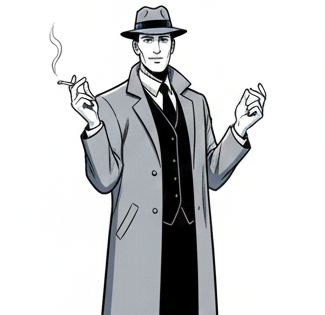Read time: 9 minutes
10 minutes into the sales call and you're already sweating
You're 10 minutes into the call with this hotel chain CTO - the biggest lead you got so far from the $3k/month cold email campaign - and your palms are sweating.
He just described their mobile app project, but you have no idea what their backend actually looks like. APIs? Legacy databases? Some homegrown mess from 2003?

You want to ask, but you don't want to sound clueless. So you nod along and start talking about your React Native expertise. You want to show him you're a serious engineer, not a kid who just got out of a coding bootcamp.
You get excited, even animated, but the CTO isn't fully there with you. He even glances at his phone.
Then the bombshell lands - "So how much would something like this cost?"
Shit. Your mind races. Could be $50K, could be $200K - depends on their backend. But you don't want to lose them, so you hedge: "Well, probably somewhere in the $40-80K range..."
"Oh. We got quotes from other agencies around $15k. You're out of our budget."
But that wouldn't even cover your costs! How can you compete with that?
In the meantime in an alternate reality...
You're 3 minutes into the call with the CTO and you're completely calm. You know exactly what you're doing and how this is going to go.
"Tell me about the biggest frustration your staff has with the current system."

He launches into a detailed story - staff can't see real-time room availability, the old system crashes during peak check-in, managers have no visibility into productivity metrics. Apparently this happens at least once a week.
"And when the system crashes, what happens to your guest experience?"
Now he's getting animated. Lost bookings, frustrated guests, staff calling IT in a panic.
You lean forward. Game on.
30 minutes later, he says:
"You aren't cheap, but I don't think anybody else can handle this as well as you guys can. How soon can we start?"
Now, I saw plenty of people go from sweaty palms to calm confidence, but Tony's transformation was something else -
How Tony went from $0 to $120k in one call
Tony runs a small dev agency out of an apartment in Amsterdam that he shares with his girlfriend and adopted son.
He's a tech veteran with multiple startups and a couple of viral projects to his name, but getting clients consistently for his agency had always been a struggle. He'd been getting few good leads for his agency each month, but he kept overwhelming them by "going in too hard" trying to prove his worth to them.
As he put it:
"I had a missed opportunity with this prospect spending $20k a month... I just went in too hard trying to prove my worth. They didn't know I could do a great job - I was just overwhelming them."
When a new opportunity came along after the Founder Sales System training, Tony completely rethought his approach. Instead of rushing to present his standard engineering retainer, he was able to "lead prospects down a path at their pace, not his" and craft proposals based on what they actually cared about.
The result?

"This client, by the end of this year will probably have spent well over 6 figures ($120k - EF) with us. In a way that only takes me personally a couple of hours a week to manage."
More importantly, Tony went from being "maybe a 6 out of 10" confident in sales to "9 out of 10 confident that if we can do a good job for this lead, even if they're cold and they don't know me, then I'll be able to close them."
I know, I know, you just need to do more marketing
Almost every tech founder I talk to tells me that.
More marketing seems to be the answer, and every online online guru is telling us to do more - paid ads, SEO, blogs, websites, social media, reels, YouTube videos, articles, Twitter, Reddit, cold email, warm email, DMs of various temperatures.

It seems like a never ending list full of promise and... disappointment.
It's not your fault that you believe that you need to do more marketing.
I followed the same path myself - 3000 followers on Twitter, 13k karma on Reddit, ungodly amounts spent on paid ads.
Barely any deals.
Nothing changed until I learned how to have a conversation with another human being that I've never met before - and end up with a deal in hand - a.k.a. sales.
I always thought sales was this slimy, oily, dishonorable thing, that you have to do in the same way you have to clean the latrines. Sales seemed like a dishonest way of getting people to buy things they don't need with money they don't have.
It's not your fault you feel this way too. The trope of the used car salesman in his ill-fitting suite waving his hands around is just too prevalent.
But sales doesn't have to be like that.
When the actual tech founder does it, sales can be honest, ethical, clean - and very detail oriented.
And it's quick too - so you can go back to what you do best - building software.
Just close some deals and get back to building
A salesperson would tell you to get your energy up, jump around, dance like a monkey, and then hit the phones with that energy. I'd never tell you to do that. I'm an introverted engineer, and so likely are you. We'll meet our prospects with skill, curiosity, and exacting attention to detail - as engineers, not as salespeople flapping their wings.
And we want to get it over with as quickly as possible.
Here's how the systematic approach actually works:

We'll break sales conversations into 5 systematic steps - each with clear objectives and success signals. It's not quite as straightforward as debugging a nasty race condition, but it's definitely doable by mere mortal (and even slightly autistic) engineers.
THE 5-STEP SALES PROCESS
Step 1: How to ask the right questions
- Know exactly what questions reveal what they actually want to buy (as opposed to what they say)
- Clear success signal: You understand their real problem (not just what they say they need)
Step 2: How to reflect their answers
- Make sure you truly understand what they told you (and that they believe you understand them!)
- Clear success signal: They feel genuinely understood (you'll know when this happens)
Step 3: How to offer a solution
- Frame your solution so buying becomes obvious and (almost) inevitable
- Clear success signal: They're nodding along, seeing how it fits their specific situation
Step 4: How to handle objections
- Address the real objection (they always say it's about price, but it's almost never about price)
- Clear success signal: Their resistance dissolves because you've addressed the root concern
Step 5: How to close
- Know exactly what to do when they "need to think about it"
- Clear success signal: They're ready to move forward or you have a clear next step
You approach each conversation with the same systematic thinking you use to solve technical problems. No fake high energy, no manipulation - just methodical progress through proven steps with clear success criteria at each stage.
It requires some practice, but it isn't magic. It's just a carefully engineered system with plenty of redundancies.
And the ultimate success signal is the best one yet, because you get to decide which deals you take and which deals you walk away from.
How I figured out sales - by failing spectacularly
Back in 2021, I was desperately trying to get customers for an app I built called Wuju.
This app literally healed my depression and even went slightly viral on Hacker News, but making money off it felt like sinking in quicksand while chewing nails. After 6 months of random (and ineffective) marketing efforts someone suggested I try to sell it one on one before I try to scale with marketing (good advice, btw).
I had nothing to lose at this point except whatever was left of my dignity and I threw myself at it. I managed to book 40 calls in just two weeks - back to back for 4 hours straight each day.
Unfortunately, I was terrible at it. All I wanted was to show them my app, thinking that the thing would speak of itself - and convince them to pay. It didn't, even when they had a major emotional breakthrough right there on the Zoom call.
I was obviously missing something, and in a typical left-brain engineer fashion, sat down to debug the calls. Pen in hand, transcripts printed out, I poured through the calls to figure out where I lost each prospect. I could literally see it in the text - they were engaged and animated one minute, and completely gone the next.
I started documenting every drop-off point, every conversation killer, slowly getting a tiny bit better one conversation at a time over those two weeks.
By the end of it, I actually closed two $30/month licenses on the spot - my very first sales ever. The economics were absolutely terrible - $30/month including software plus weekly coaching sessions worked out to something like $7.50/hour - but it proved something important about sales - it was crackable, even for a socially inept geek like me.
Wuju ultimately didn't work as a business, but learning how to sell allowed me to scale my coaching practice to $400 and even $600/hour arrangements and I live comfortably off it these days.
Inside the Founder Sales System
This system is the distillation of 4 years of experimentation, dozens of books, and hundreds of call transcripts.
Distillation means it's short, condensed and to the point - 2 hours of video and a few short guides for specific situations you may come up against. You can go through it by the end of the day, and close (or recover!) your first deal tomorrow.

The core system
- 5-Step sales conversation framework
- 2-hour video focused training in eight 15-minute chunks
- Rejection-free approach for technical founders and agency owners
The chapters
01 Founder Sales System Introduction
02 Mastering the 5 Stages of a Sales Conversation
03 The Secret to Effortless Sales Conversations
04 Sales Isn’t Theory - It’s Practice
05 How to Handle Boasters, Complainers & Break Through Emotional Blocks
06 Hypothetical Solutions & Handling Objections Like a Pro
07 How to Break Through Sales Resistance & Turn Skeptical Prospects into Buyers
08 The Sales Mistake That’s Killing Your Deals
09 How to Lead, Anchor, and Persuade Without Being Pushy
10 How to Handle Decision Objections & Close More Deals Without Getting Ghosted
Bonus 1: How to recover from ghosting
Ever sent a detailed offer to a promising prospect only to never hear from them again?
It hurts your bank balance of course, but it hurts your soul even more. All that excitement - and then crickets.
You'll never face another client ghosting you once you start using the Founder Sales System. But just in case you recently sent a proposal and haven't heard from them since, this guide will show you how to get them back to the table - and this time do it properly.
Bonus 2: How to renegotiate a slipped deadline
You probably heard of (or at least felt) Hofstadter's law: It always takes longer than you expect, even when you take into account Hofstadter's law.
Your clients haven't. And they probably aren't very happy about the slipping deadlines.
This guide will show you how to use the same psychological principles we use in the Founder Sales System to renegotiate your agreements when costs balloon, timelines slip, and tech debt creeps in - all to both your benefit and the benefit of your clients.
All it takes is a little reframing.
Bonus 3: How to set clear boundaries with a client
Your Slack pings, "Let's hop on a call to discuss." It's the third time this week. The third time Jim has changed his mind about the damn color of the login button. Enough is enough. But what do you say? How do you politely tell him to f*** off without losing the contract or damaging your carefully built reputation?
This guide is about establishing clear and healthy boundaries to make sure all your relationships are professional, courteous, and - importantly - profitable.
How much it costs (and why it pays for itself)
The presale launch price of the entire system is $997 (the course is ready, but I'm finishing up the bonus guides as we speak).
The price goes up to $1497 in 48 hours when the guides are ready (November 24th at midnight UTC).
My 30-day money back guarantee
I give a 30-day “close one deal or get your money back” guarantee:
If you go through the entire system, have at least three sales calls, and don’t sign at least one new client (or raise prices or scope on an existing one), I’ll refund you 100%, no questions
Never Compete on Price Again
Get ready to close a profitable deal on your next discovery call
Start SellingOne last question - How's your runway?
I made my case the best way I know how to, and frankly I'm much better at this on a Zoom call than I am on an web page. But the question about the runway is important.

There are basically two options here - you either have infinite runway because your agency is generating enough revenue to pay the bills, the contractors, and for your own lifestyle - or you don't.
If you're on infinite runway and have a steady trickle of new contracts, you're in a good spot. This system may help you grow, scale, perhaps even buy a nice car or retire early, but it isn't essential.
But if you're burning through your cash reserves, or running on debt, or are just one cancelled contract away from needing to get a job... I mean... regardless of how much money or effort you pour into marketing, you're going to end up on calls with prospects.
And you'll need to know what you're doing when you do.
Eli Finer
eli@finereli.com